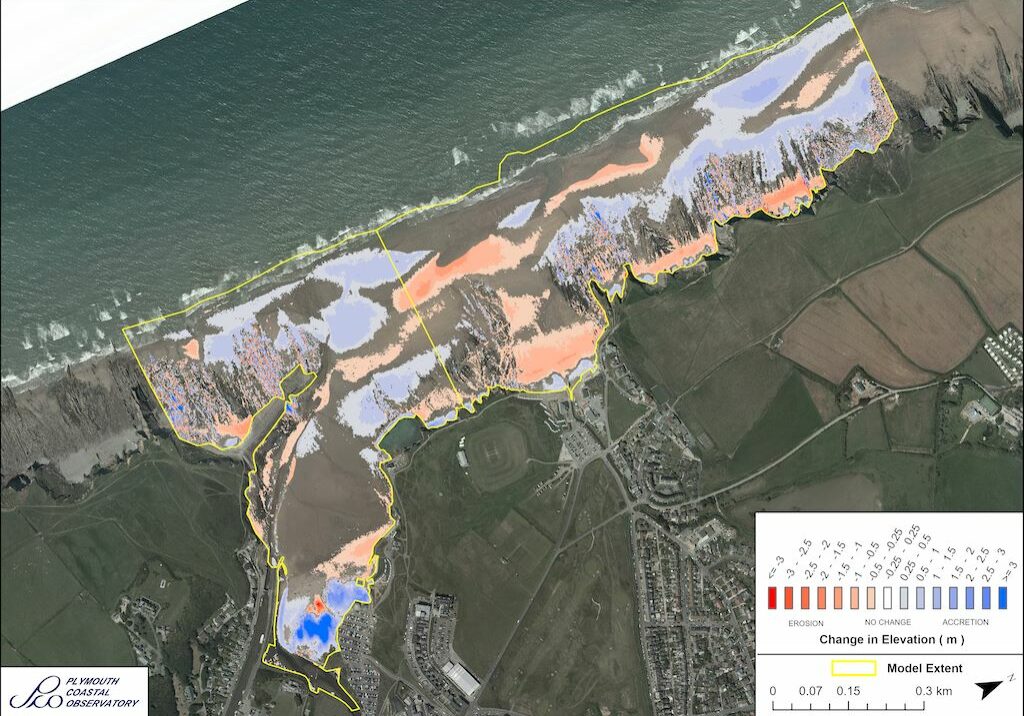
Crooklets, locally referred to as Maer Lake, is a west facing beach associated with Bude/Flexbury in north Cornwall. Though Crooklets is influenced by the River Neet, the mouth of Crooklets Stream flows down the middle of the beach. Crooklets Stream has a relatively small catchment, of a shallow gradient, that mainly drains water from the Flexbury and Poughill area.
Though Crooklets is part of the wider Bude Bay, the beach is fringed by rocky ridges and platforms and access only possible to the wider Bay as the tide drops. The intertidal of Crooklets is composed of fine sand, rich in shell fragments, with a pebble and cobble ridge forming above highwater.
Historically, prior to the development of the area, sand would have migrated further inland over the extensive Summerleaze Downs. Now, the uppershore of Crooklets, with its promenade and beach huts, is more fixed, and the Downs, though open in some areas, has partially been developed into a golf course. With no space being available for the coastline to rollback it makes parts of Crooklets vulnerable to storm surges and more sensitive to sea level rise.


Coastal Change
The coastline of Cornwall is an ever-changing environment. It is energetic, dynamic, never still and changes with each wave and each tidal cycle. Some of the changes we see are gradual and barely noticeable, whilst others, such as rockfalls, happen suddenly and often shockingly.
From one visit to the next it can sometimes be difficult to see how a beach and dune system has changed, but information has been collected, and is being collected through the Making Space for Sand project, to help us better understand how the coastline is changing. The purpose of this section of the website is to understand each location has changed over time, how it could change in the future and understand the policies that influence how we can respond to these changes.
Shoreline Management Plans (SMP)
The Shoreline Management Plan (SMP) is a strategic planning and management assessment tool that helps identify and measure the risk associated coastal erosion and coastal flooding. The document makes a number of policy recommendations over short, medium and long term timeframes setting out a strategic approach to managing the built, natural and historic environments associated with the coastline. Within SMP there are four policy approaches which have been assigned to stretches of coastlines. The four policies are: No Active Intervention (NAI), Hold the Line (HTL), Managed realignment (MR), and Advance the line (ATL).
Crooklets sits within Policy Development Zone 16 (PDZ16), in Management Area 40 (MA40), within Policy Unit (PU) 40.4. The policy recommendations for this policy unit are detailed in the table below and the SMP can be accessed through the Cornwall Council website.
Use your touchscreen
to scroll the below table
| Policy Unit | SMP2 Policy Plan | ||||
| 2025 | 2055 | 2105 | Comment | ||
| 40.4 | Crooklets beach
Main Policy Sub Policy
|
MR P
|
MR P
|
NAI LAO |
Policy aims to create a robust natural defence with improvement to dune systems while relocating tourist infrastructure and commercial development away from erosion zones. The long-term policy intent is to allow natural evolution and process to occur.
|
| Key Main Policy: HTL - Hold the Line, A - Advance the Line, NAI – No Active Intervention, MR – Managed Realignment
Sub Policy: P – Placeholder, LAO – Local Activity Only |
|||||


National Coastal Erosion Risk Mapping (NCERM)
National Coastal Erosion Risk Mapping (NCERM) provides a baseline of coastal erosion, for the coastline of England, over short, medium and long-term timeframes. The data is based on the natural and defence characteristics of the coastline and provides rates of erosion at differing levels of confidence to help better plan for worse case scenarios. The data provided is for guidance and does not estimate the absolute location of the future coastline.
The basic NCERM lines show erosion estimates for the Short Term (ST-20 years), Medium Term (MT-50 years) and Long Term (LT- 100 years). The data is further categorised by probability: 05 is 5% probability (a 1 in 20 chance of being exceeded) Red Shading, 50 is 50% probability of being exceeded (a 1 in 2 chance of being either exceeded or not exceeded) Orange Shading and 95 is 95% probability (a 19 in 20 chance of being exceeded) Yellow Shading. Click the link below to access the Cornwall Council NCERM Mapping site read the about section then click on layers.

Historical Images of Crooklets
Historical photographs provide a powerful insight into how the Cornish coastline has changed within the past Century. The Making Space for Sand project are working in collaboration with the Francis Frith collection and have been given permission to share historical images on a number of beaches considered within the project.
In looking back, we can better understand how the coastline has changed, helping us understand not only how the coastal fringe has developed but also the potential future changes that we my observe. When this is considered alongside forecasts of coastal erosion and sea level rise it will help enable us to better adapt to our changing coastline.
Image of Crooklets beach from Summerleaze Downs in c1960 (Image courtesy of the Francis Frith collection) and in 2023.
Image of Crooklets beach from Summerleaze Downs in 1926 (Image courtesy of the Francis Frith collection) and in 2023.
Image of Flexbury and Crooklets carpark in 1920 (Image courtesy of the Francis Frith collection) and in 2023.

Modelling Coastal Change
Using data that has already been collected, combined with data collected through the Making Space for Sand project, a series of models will be carried out at each location. This will help us better understand how each location may respond to sea level rise and gain a deeper understanding of how coastal sediments move and behave.
The complexity of the modelling, and the data collection that helps inform it, means that modelling outputs will not be the same on all sites. Some locations will be more thoroughly investigated to understand more complex issues and provide data that can be more widely applied to other sites with similar characteristics.
As the project develops this section of the website will expand, sharing new reports and coastal change projections when they are produced.

LiDAR surveys, which are explained on the Data Modelling page, have been carried out by the South West Coastal Monitoring program at this location. The image shared here visualises where sand has eroded (areas shaded in red) and where it has built up (areas shaded in blue), between the LiDAR surveys carried out in 2003 and 2019. The darker the shade of red or blue the greater the amount of sand erosion or accumulation has been observed. The image helps visualise that beaches are areas that change shape over time and will continue to do so as sea levels rise.


Designations
The coastline represents an important transition between the marine environment and the terrestrial environment. This transition creates a range of special habitats and exposes a range of interesting features, which that can result in these spaces being highly designated and protected. There are a range of designations that recognise a variety of different features. At this location these designations are explored below.
Site of Special Scientific Interest (SSSI)
A Site of Special Scientific Interest or SSSI is a statutory conservation designation notified by Natural England denoting protection for biological and/or geological characteristics. The natural wildlife and geological features of SSSI’s are considered to be irreplaceable parts of the national heritage. These are protected in order to preserve their importance, and to prevent damage and development.
The Bude Coast SSSI covers an area of 92.5 hectares and considers the cliffs between Compass Cove and Furzey Cove, immediately adjacent to Bude. The stretch of coastline exhibits important geological features, and the coastal cliff-top grassland to the south of Bude Haven support a number of rare and locally restricted plants.
Image of the chevron folds at Millook Haven (Courtesy of Coralie Barrow)
Marine Conservation Zone (MCZ)
A Marine Conservation Zone (MCZ) is a type of marine protected area, designated in English, Welsh and Northern Ireland territorial offshore waters, to protect a range of nationally important, rare or threatened marine habitats or species by halting or reversing damage and degradation caused by human activities.
The Hartland to Tintagel MCZ covers an area of 304km2 following the coastline along, along Mean High Water (MHW) from Hartland Point to Tintagel Head. The MCZ contains deeper water and intertidal rocky and sandy habitats home to a diversity marine creatures, such as the sponges, honeycomb worms and pink sea-fans.
Image of a Celtic sea slug on the edge of a rockpool
Sign up to Making Space for Sand
If you would like to get involved in helping to make dunes more resilient and biodiverse, want to help develop coastal adaptation and emergency plans or just want to know more about what the project is learning about coastal change, please click here:








